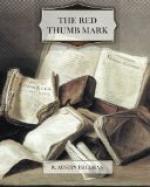“Yes. I have recently made some experiments on the subject.”
“Will you give us the results of those experiments?”
“My object was to ascertain whether fingers wet with fresh blood would yield distinct and characteristic prints. I made a great number of trials, and as a result found that it is extremely difficult to obtain a clear print when the finger is wetted with fresh blood. The usual result is a mere red blot showing no ridge pattern at all, owing to the blood filling the furrows between the ridges. But if the blood is allowed to dry almost completely on the finger, a very clear print is obtained.”
“Is it possible to recognise a print that has been made by a nearly dry finger?”
“Yes; quite easily. The half-dried blood is nearly solid and adheres to the paper in a different way from the liquid, and it shows minute details, such as the mouths of the sweat glands, which are always obliterated by the liquid.”
“Look carefully at this paper, which was found in the safe, and tell me what you see.”
The witness took the paper and examined it attentively, first with the naked eye and then with a pocket-lens.
“I see,” said he, “two blood-marks and a print, apparently of a thumb. Of the two marks, one is a blot, smeared slightly by a finger or thumb; the other is a smear only. Both were evidently produced with quite liquid blood. The thumb-print was also made with liquid blood.”
“You are quite sure that the thumb-print was made with liquid blood?”
“Quite sure.”
“Is there anything unusual about the thumb-print?”
“Yes. It is extraordinarily clear and distinct. I have made a great number of trials and have endeavoured to obtain the clearest prints possible with fresh blood; but none of my prints are nearly as distinct as this one.”
Here the witness produced a number of sheets of paper, each of which was covered with the prints of bloody fingers, and compared them with the memorandum slip.
The papers were handed to the judge for his inspection, and Anstey sat down, when Sir Hector Trumpler rose, with a somewhat puzzled expression on his face, to cross-examine.
“You say that the blood found in the safe was defibrinated or artificially treated. What inference do you draw from that fact?”
“I infer that it was not dropped from a bleeding wound.”
“Can you form any idea how such blood should have got into the safe?”
“None whatever.”
“You say that the thumb-print is a remarkably distinct one. What conclusion do you draw from that?”
“I do not draw any conclusion. I cannot account for its distinctness at all.”
The learned counsel sat down with rather a baffled air, and I observed a faint smile spread over the countenance of my colleague.
“Arabella Hornby.”
A muffled whimpering from my neighbour on the left hand was accompanied by a wild rustling of silk. Glancing at Mrs. Hornby, I saw her stagger from the bench, shaking like a jelly, mopping her eyes with her handkerchief and grasping her open purse. She entered the witness-box, and, having gazed wildly round the court, began to search the multitudinous compartments of her purse.




